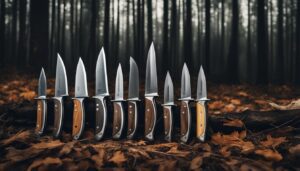When selecting a hunting knife, it’s important to consider the length of the blade. The right blade size can greatly impact your outdoor experience and the tasks you can accomplish. Texan Knives offers a variety of outdoor knives, including fixed-blade knives, folding knives, survival knives, EDC knives, multi-tool knives, and fishing knives. Each type of knife has its own unique features and advantages.
Fixed-blade knives, like hunting knives, are a popular choice for their strength and reliability. Survival knives are designed to handle a range of tasks and often come with additional features. Folding knives offer portability and easy storage. EDC knives are lightweight and versatile, suitable for everyday use. Multi-tool knives combine a knife with other essential tools. Fishing knives, like fillet knives, are designed specifically for cleaning and preparing fish.
When choosing a hunting knife, consider the purpose, size and weight, blade material, handle material, and budget. Texan Knives offers a range of price points, ensuring you can find the perfect knife within your budget.
Key Takeaways:
- Choosing the right blade size is crucial for a successful hunting experience.
- Texan Knives offers a variety of outdoor knives, each with its own unique features and advantages.
- Consider the purpose, size and weight, blade material, handle material, and budget when choosing a hunting knife.
- Fixed-blade knives are popular for their strength and reliability, while survival knives offer additional features.
- Folding knives provide portability, EDC knives are lightweight and versatile, and fishing knives are designed for cleaning and preparing fish.
Factors to Consider When Choosing a Hunting Knife
When selecting the perfect hunting knife, there are several factors to consider. First, think about the primary tasks you’ll be using the knife for and choose a blade length designed for those specific functions. A shorter blade, such as 3-4 inches, is ideal for precision tasks like skinning and caping, while a longer blade, around 5-7 inches, is better suited for larger game and general utility tasks.
Consider the overall size and weight of the knife and how it will affect your ability to carry and use it comfortably. A lightweight and compact knife is convenient for everyday carry, while a heavier and larger knife may be preferred for more demanding tasks in the field.
Blade material is also important, as it can impact a knife’s performance, sharpness, and durability. Stainless steel and high-carbon steel are commonly used blade materials, with each having its own advantages. Stainless steel offers excellent corrosion resistance, while high-carbon steel provides superior edge retention.
The handle material is another crucial factor to consider, as it affects comfort, grip, and durability. Common handle materials include wood, bone, plastic, and synthetic materials like G-10 and Micarta. Each material offers different levels of grip and aesthetic appeal, so choose one that suits your preferences and intended use.
| Factor | Description |
|---|---|
| Blade Length | Choose a blade length suitable for your intended tasks. Shorter blades are ideal for precision tasks, while longer blades are better for larger game and utility tasks. |
| Size and Weight | Consider the overall size and weight of the knife for comfortable carry and use. Lightweight and compact knives are convenient for everyday carry, while heavier and larger knives are suitable for more demanding tasks. |
| Blade Material | Blade material impacts performance, sharpness, and durability. Stainless steel offers corrosion resistance, while high-carbon steel provides superior edge retention. |
| Handle Material | Choose a handle material that offers comfort, grip, and durability. Common options include wood, bone, plastic, and synthetic materials like G-10 and Micarta. |
| Budget | Determine your budget before shopping for a hunting knife to ensure you find a quality knife within your price range. |
Lastly, determine your budget before shopping for a hunting knife. Quality knives are an investment that should last for years, so it’s important to find one that fits your budget without compromising on quality. With these factors in mind, you can make an informed decision and choose a hunting knife that meets your specific needs and preferences.
Maintenance and Care Tips for Your Hunting Knife
Proper maintenance and care are vital for keeping your hunting knife in optimal condition and ensuring its longevity and performance. By following these maintenance and care tips, you can keep your knife sharp, rust-free, and ready for any outdoor adventure.
Cleaning
After each use, it is essential to clean your hunting knife thoroughly. Use warm, soapy water and a soft cloth or sponge to remove dirt, debris, and moisture from the blade and handle. Pay close attention to the pivot area, where dirt can accumulate in folding knives. Dry the knife completely with a clean cloth to prevent rust or corrosion.
Sharpening
Regular sharpening is necessary to maintain the sharpness and cutting performance of your hunting knife. Use a sharpening stone, honing rod, or knife sharpener designed for your blade type to restore the edge. Hold the knife at the correct angle and apply light pressure while running the blade along the sharpening tool. Remember to sharpen both sides of the blade evenly for optimal results.
Lubrication and Storage
Periodically lubricate your hunting knife to ensure smooth opening and closing in the case of folding knives. Apply a few drops of lubricating oil to the pivot area and any other moving parts. This will help prevent friction and ensure ease of use. When storing your knife, choose a dry and cool environment to prevent rust and corrosion. You can use a protective sheath or blade cover to keep the knife secure and shielded from moisture and other potential damages.
Inspection
Regularly inspect your hunting knife for signs of wear, damage, or rust. Check the blade for any nicks or chips, which can affect its cutting ability. If you notice any issues, address them promptly. Depending on the severity of the damage, you may need to seek professional assistance for repairs or blade replacement. Taking proactive steps to address any issues will ensure that your hunting knife remains in excellent condition and ready for your next outdoor excursion.
Further Exploration and Development in the World of Knives
As you become more familiar with your hunting knife and its uses, there are several ways to further explore and develop your knowledge and skills in the world of knives. Consider attending knife workshops and classes to learn from experts and enthusiasts who can share their expertise and techniques. These workshops provide hands-on experiences and valuable insights into knife safety, sharpening techniques, and advanced cutting methods. By participating, you can enhance your understanding of knives and gain practical skills that will improve your knife handling abilities.
Another avenue for expanding your knowledge is to enroll in outdoor survival courses. These courses not only teach you essential wilderness skills but also emphasize the proper use of knives in various survival situations. Learning how to effectively utilize your hunting knife for shelter building, fire starting, food preparation, and self-defense will greatly enhance your outdoor adventures and ensure your safety in challenging environments.
Engaging with the knife community is also a great way to expand your knowledge and share your passion. Joining online forums or social media groups dedicated to knives and outdoor enthusiasts allows you to connect with like-minded individuals, exchange ideas, and gain valuable insights and advice. This community provides a platform for discussing various knife topics, sharing experiences, and discovering new techniques, tools, and resources.
If you have a desire to personalize and customize your knife, there are several options available to you. Many knife manufacturers and custom knife makers offer customization services, allowing you to add personalized engravings, choose unique handle materials, or even design a completely customized knife. Customization not only adds a personal touch to your knife but also enhances its aesthetic appeal and makes it uniquely yours.
Lastly, consider expanding your collection of knives as your interests evolve. There is a wide variety of knives available, each designed for specific purposes and tasks. By collecting knives with different blade styles, lengths, and materials, you can ensure that you always have the right tool for the job. Building a diverse collection allows you to explore different designs, innovations, and brands, and provides you with a range of options for various outdoor activities.
With the myriad of opportunities for further exploration and development in the world of knives, you can continue to refine your skills, knowledge, and collection. Whether it’s through workshops and classes, survival courses, engaging with the knife community, customization, or expanding your collection, the world of knives offers endless possibilities for growth and enjoyment.
Conclusion
In conclusion, selecting the perfect hunting knife length is essential for a successful outdoor adventure. Texan Knives offers a wide range of hunting knives and outdoor knives, each with its own unique set of features and advantages. When choosing a hunting knife, it’s important to consider factors such as purpose, size and weight, blade material, handle material, and budget.
Moreover, proper maintenance and care are crucial to ensure the longevity and optimal performance of your hunting knife. By following the maintenance and care tips provided, you can keep your knife in excellent condition and enjoy years of reliable performance.
To further explore and develop your knowledge and skills in the world of knives, consider attending workshops or classes, enrolling in outdoor survival courses, and joining online communities dedicated to knives and outdoor enthusiasts. Customizing your knife and expanding your collection are also great ways to enhance your experience and have the right tool for any job.
In summary, with the right hunting knife by your side and a passion for adventure, you’ll be well-equipped to tackle any outdoor challenge. Remember to choose the perfect hunting knife length, maintain it properly, and continue expanding your knowledge and skills in the fascinating world of knives.
FAQ
What factors should I consider when choosing a hunting knife?
When choosing a hunting knife, factors to consider include purpose, size and weight, blade material, handle material, and budget.
How should I maintain and care for my hunting knife?
Proper maintenance and care for your hunting knife include cleaning after each use, regular sharpening, lubrication for folding knives, storing in a dry environment, and regular inspection for wear and damage.
How can I further explore and develop my knowledge and skills in the world of knives?
You can attend knife skills workshops or classes, enroll in outdoor survival courses, join online knife and outdoor enthusiast communities, and explore customization options for your knife.
What is the importance of choosing the right hunting knife length?
The right hunting knife length is crucial for performing various tasks and enhancing your overall outdoor experience.





